*NURSING > QUESTIONS & ANSWERS > Chapter 43: Care of the Patient with a Musculoskeletal Disorder (All)
Chapter 43: Care of the Patient with a Musculoskeletal Disorder
Document Content and Description Below
Chapter 43: Care of the Patient with a Musculoskeletal Disorder Chapter 43: Care of the Patient with a Musculoskeletal Disorder Cooper and Gosnell: Foundations and Adult Health Nursing, 7th Edition M... ULTIPLE CHOICE 1. What is the movement of an extremity away from the midline of the body called? a. Abduction b. Adduction c. Flexion d. Extension 2. What is the large, fan-shaped muscle that covers the anterior chest from the sternum to the proximal end of the humerus and acts on the joint of the shoulder to flex, adduct, and rotate? a. Serratus anterior b. Intercostal c. Transversus abdominis d. Pectoralis major 3. What should the nurse instruct the patient before a magnetic resonance imaging (MRI) procedure? a. Void to completely empty the bladder b. Omit all citrus food for 12 hours before the procedure c. Remove all metal, such as jewelry, glasses, and hair clips d. Wear only cotton garments for the procedure 4. The nurse instructs the patient who is to have a unicompartmental knee replacement that a major advantage of this partial knee replacement is that: a. the patient will be up and walking 2 to 3 hours after the operation. b. the kneecap is completely removed. c. the procedure is especially helpful in the treatment of rheumatoid arthritis. d. a small titanium disk replaces the worn cartilage. 5.A patient who has had a right below the knee amputation continues to complain of unpleasant sensation in the right foot. What can the nurse explain about this “phantom pain”? a. It only exists in the mind. b. It is a complication following an amputation and can be clarified by the surgeon. c. It is related to the severed nerves that are still sending messages to the brain. d. It occurs when the person becomes focused on the loss of the limb. 6.The patient that has a bipolar hip replacement following an intracapsular fracture has an order to be turned every 2 hours. The nurse understands that the correct nursing intervention is to keep the legs: a. together so they do not separate while turning. b. flexed to stabilize the prosthesis. c. abducted so the prosthesis does not become dislocated. d. adducted to prevent additional pain for the patient with turning. 7.A patient has been casted to stabilize a fracture of the right radius and ulna. The nurse assesses a capillary refill of 5 seconds and cold fingers of the right hand. Which initial intervention should the nurse deploy? a. Notify the charge nurse of a probable compartment syndrome b. Apply a warm compress to the fingers to relieve swelling c. Elevate the right hand to heart level to maintain arterial pressure d. Cut the cast off to release constriction 8.A patient had an open reduction with internal fixation (ORIF) for a compound fracture of the left tibia and has been placed in a long leg cast. The assessments by the nurse are: left foot warm/pink, pedal pulse weaker than right, capillary refill 3 seconds, and small 1 cm area of blood on cast. What should the nurse do? a. Notify charge nurse of impending compartment syndrome b. Document that all assessments are within normal limits c. Inform charge nurse about probable hemorrhage d. Place warm compresses on left foot 9. When a patient recovering from a fractured tibia asks what callus formation is, the nurse tells her it is: a. when blood vessels of the bone are compressed. b. a part of the bone healing process after a fracture when new bone is being formed over the fracture site. c. the formation of a clot over the fracture site. d. when the hematoma becomes organized and a fibrin meshwork is formed. 10. Which patient statement indicates the need for additional teaching for a patient with rheumatoid arthritis who is taking meloxicam (Mobic)? a. “I am keeping a daily record of my blood pressure.” b. “I take aspirin before I go to bed.” c. “I know I can take meloxicam with or without regard to meals.” d. “I weigh every day so I will be aware of any weight gain.” 11. What should the nurse include in the plan of care for a patient following a myelogram? a. Position in a semi-Fowler position for 8 hours to reduce potential of headache b. Place patient flat on back to compress puncture site c. Ambulate for brief periods to lessen postmyelogram headache d. Limit fluids to increase absorption of the dye 12. Which finding would delay a computed tomography (CT) scan? a. Patient’s allergy to shellfish b. Patient in first trimester of a pregnancy c. Patient’s allergy to milk products d. Patient’s gluten intolerance Step: Assessment MSC: NCLEX: Physiological Integrity 13. Forty-eight hours after a patient sustained a fractured femur in a car accident, the nurse assessed a pulse of 110, respirations at 25, and labored crackles in both lung fields. The nurse immediately reports to the charge nurse the probability of a(n): a. impending pneumonia. b. atelectasis. c. fat embolism. d. anxiety attack. 14.What is the first priority nursing intervention for an impending fat embolism? a. Administer oxygen in a respiratory emergency b. Increase intravenous fluids c. Position in flat position to ease decreased blood pressure d. Cover with warm blanket 15.A patient, age 68, has suffered an intertrochanteric fracture of the right hip. Before surgery, to provide support and comfort, an immobilizing device of a is applied. a. Thomas splint b. Bryant traction c. Russell traction d. Buck traction 16. Which foods should the home health nurse suggest for the patient with osteoporosis to help slow the disease? a. Leafy green vegetables b. Foods high in sodium c. Tea and coffee d. Vitamin A 17. What should the nurse include in the teaching plan for a patient who is taking alendronate (Fosamax)? a. Take drug with any meal b. Take drug first thing in the morning c. Drink at least 5 oz of milk before taking drug d. Take drug with an antacid to avoid heartburn 18. The patient has been diagnosed as having gouty arthritis. The patient asks the nurse to explain the cause of the inflammation of the great toe. What is the most appropriate nursing response? a. “You have calcium oxalate deposits that are seen in gouty arthritis.” b. “The inflammation is from small accumulations of uric acid crystals, which are called tophi.” c. “The small nodules are not related to the arthritis condition.” d. “You have fat deposits that are common with gouty arthritis.” 19. When the patient with rheumatoid arthritis complains about the daily exercise, the nurse encouragingly reminds the patient that exercises: a. keeps the joints from “freezing.” b. will ensure better sleep. c. should be vigorous for joint stimulation. d. need not be done daily. KEY: Nursing Process Step: Assessment MSC: NCLEX: Physiological Integrity 20. The nurse clarifies to a patient who is being evaluated for possible rheumatoid arthritis that the elevated erythrocyte sedimentation rate indicates the presence of: a. immunoglobulin M. b. abnormal serum protein. c. increased inflammatory reaction in the body. d. C-reactive protein. 21. What should the nurse instruct the patient before the initiation of the antimalarial drug hydroxychloroquine (Plaquenil)? a. Get a complete blood count to assess anemia. b. Get a chest x-ray. c. Get an eye examination. d. Take prophylaxis for malaria. 22. What should the nurse do when a patient with osteomyelitis is admitted with an open wound that is draining? a. Enforce a low calorie diet b. Initiate drainage and secretion precautions c. Frequently do passive ROM on the elbow d. Ambulate several times daily 23.A 16-year-old male patient presents in the emergency room with a pathologic fracture of the left femur and complains of pain on weight bearing. These are cardinal indicators of: a. osteogenic sarcoma. b. osteoporosis. c. rheumatoid arthritis. d. osteochondroma. 24.The 14-year-old boy who is scheduled for left leg amputation says to the nurse, “What in the world am I going to do with only one leg?” What is the nurse’s most therapeutic response? a. “What are you thinking about right now?” b. “With a prosthesis, you will be as good as new.” c. “It is way too early to be concerned about that now.” d. “When my brother had his leg removed, he did great!” 25.A patient has undergone a bipolar hip repair (hemiarthroplasty). Which is the most appropriate instruction? a. Sit in whatever position is most comfortable b. Sit in a firm, straight-backed chair at a 90-degree angle c. Avoid crossing the legs d. Begin full weight bearing as soon as tolerated 26. The nurse explains to a patient who has had a knee replacement that warfarin (Coumadin) is ordered to: a. increase the red blood cells. b. reduce the threat of hemorrhage. c. prevent formation of emboli. d. help stabilize the prosthesis. 27. What should the nurse stress to a post–hip replacement patient in quadriceps setting exercises? a. Push knee down to mattress and raise heel off the bed b. Flex knee and extend foot c. Adduct leg and flex foot d. Lift leg and heel off the bed 28. What should the home health nurse include assessment for in the plan of care for an 82-year-old female with severe kyphosis from ankylosis? a. Urinary output b. Respiratory effort c. Sleep cycle d. Nutritional status 29. What should the nurse stress to a patient who has had a hip replacement and is beginning strengthening exercises for the unaffected leg? a. Flex the knee and flex the foot b. Lift the leg from the mattress and rotate the foot c. Pull knee to chest and extend the foot d. Push foot down against the footboard for a count of five 30. The office nurse has noted the presence of an increase in lumbar curvature in a 20-year-old female patient. What is this condition known as? a. Scoliosis b. Lordosis c. Kyphosis d. Spondylitis 31. How is rheumatoid arthritis distinguished from osteoarthritis? a. Rheumatoid arthritis is an autoimmune, systemic disease; osteoarthritis is a degenerative disease of the joints. b. Rheumatoid arthritis is an autoimmune, degenerative disease; osteoarthritis is a systemic inflammatory disease. c. People with osteoarthritis are considered to be genetically predisposed; there is no known genetic component to rheumatoid arthritis. d. Osteoarthritis is often caused by a virus; viruses play no part in the pathogenesis of rheumatoid arthritis. 32.Which patient is most likely to develop osteoporosis? a. 43-year-old African American woman b. 57-year-old white woman c. 48-year-old African American man d. 62-year-old Latino woman 33. The patient, age 58, is diagnosed with osteoporosis after densitometry testing. She has been menopausal for 5 years and has been concerned about her risk for osteoporosis because her mother has osteoporosis. In teaching her about her osteoporosis, which information does the nurse include? a. Even with a family history of osteoporosis, the calcium loss from bones can be slowed by increased calcium intake and exercise. b. Estrogen replacement therapy must be started to prevent rapid progression of her osteoporosis. c. With a family history of osteoporosis, there is no way to prevent or slow bone reabsorption. d. Continuous, low-dose corticosteroid treatment is effective in stopping the course of osteoporosis. 34. Certain foods may increase the pain associated with gout. Which foods have the highest concentration of purines? a. Brain, liver, kidney b. Lettuce, corn, potatoes c. Beef, pork, chicken d. Fruits and fruit juices MSC: NCLEX: Physiological Integrity 35. In order for a patient to flex the lower leg, which muscle must be contracted? a. Quadriceps b. Gastrocnemius c. Biceps femoris d. Rectus femoris 36. Calcium is a mineral found in many foods that can slow bone loss during the aging process. Which food is high in calcium? a. Oranges b. Bananas c. Spinach d. Eggs KEY:Nursing Process Step: Implementation MSC: NCLEX: Physiological Integrity 37.A 56-year-old female patient is being seen for osteoarthritis of the knee in the clinic. What should the nurse recommend when discussing strengthening exercises? a. Jogging b. Walking rapidly on a treadmill c. Bicycling d. Aerobic exercises 38. What does prolonged bed rest put the older adult at risk for? a. Ankylosing spondylitis b. Pathologic fractures c. Osteomyelitis d. Gout MULTIPLE RESPONSE 39. Which of the following are the main purposes of traction? (Select all that apply.) a. Align and stabilize a fracture b. Prevent deformities c. Relieve muscle spasms d. Promote bed rest e. Increase circulation to the rest of the body ANS: A, B, C Skin and skeletal traction provide alignment and stabilize a fracture. This prevents deformities and relieves muscle spasms by putting muscles under tension until they are fatigued. PTS: 1 DIF: Cognitive Level: Application REF: Page 1383 OBJ: N/A TOP: Traction KEY: Nursing Process Step: Assessment MSC: NCLEX: Physiological Integrity 40. The characteristics of osteoarthritis that should be included in a teaching plan would include that osteoarthritis (select all that apply): a. will cause the formation of Heberden nodes. b. can involve other organs. c. results from wear and tear. d. may affect only one side of the body. e. may cause constitutional symptoms of fatigue and fever. f. will cause marked erythema and edema of hands. 41. What are the three vital functions muscles perform when they contract? (Select all that apply.) a. Absorb uric acid b. Maintenance of posture c. Motion d. Store minerals e. Production of heat f. To assist in return of venous blood to the left side of the heart 42. Which instructions should the nurse include in a teaching plan for a person with gouty arthritis? (Select all that apply.) a. Avoid excessive alcohol. b. Maintain rest and immobility while disease is symptomatic. c. Check urine and urine output for possible kidney stones. d. Include food high in purine in the diet. e. Use bed cradle to support linens. COMPLETION 43. The division of the skeletal system that comprises the skull, hyoid, vertebral column, and thorax is the division. 44.A patient’s patellar-femoral cartilage has deteriorated due to arthritis. The medial and lateral cartilage is undamaged. This patient is likely to undergo knee replacement surgery. 45. The emergency department nurse assesses the two cardinal signs of a hip fracture in a newly admitted patient, which are the of the injured leg and the rotation of that same leg. KEY: Nursing Process Step: Assessment MSC: NCLEX: Physiological Integrity 46. The nurse administering the drug colchicine for gout will give 0.5 mg hourly for hours. 47. The nurse explains that the use of the brace allows a person with a cervical fracture to be mobile. OTHER 48. The nurse takes into consideration that a healing fracture progresses through several healing stages. Place the stages in order of healing. (Separate letters by a comma and space as follows: A, B, C, D) a. Development of fibrin meshwork b. Collagen fibers collect calcium c. Osteoblasts home fracture site form d. Callus e. Formation of hematoma f. Clot formation g. Vascularization [Show More]
Last updated: 1 year ago
Preview 1 out of 26 pages
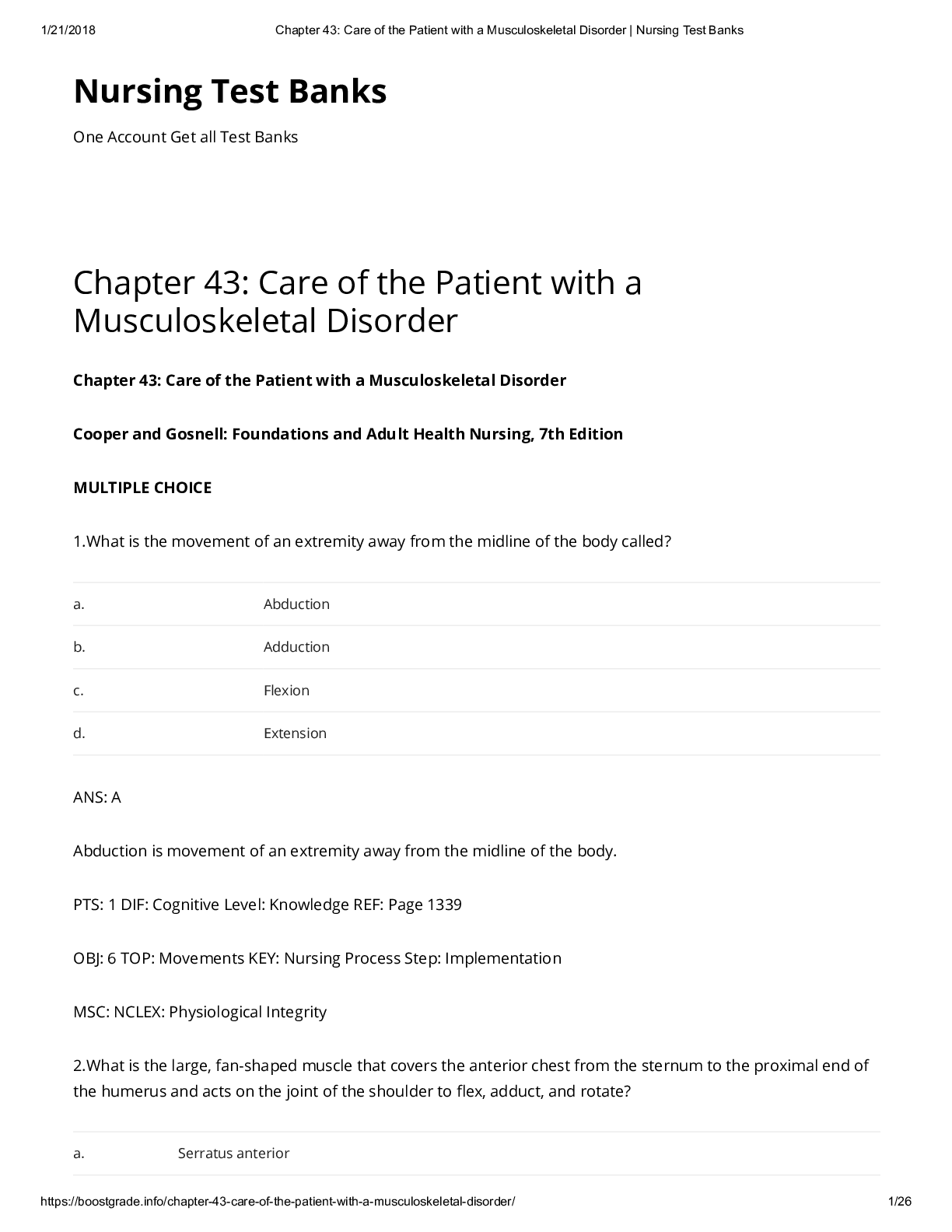
Buy this document to get the full access instantly
Instant Download Access after purchase
Add to cartInstant download
We Accept:

Reviews( 0 )
$13.50
Document information
Connected school, study & course
About the document
Uploaded On
Apr 29, 2021
Number of pages
26
Written in
Additional information
This document has been written for:
Uploaded
Apr 29, 2021
Downloads
0
Views
43

.png)
 HESI VI EXIT EXAM.png)
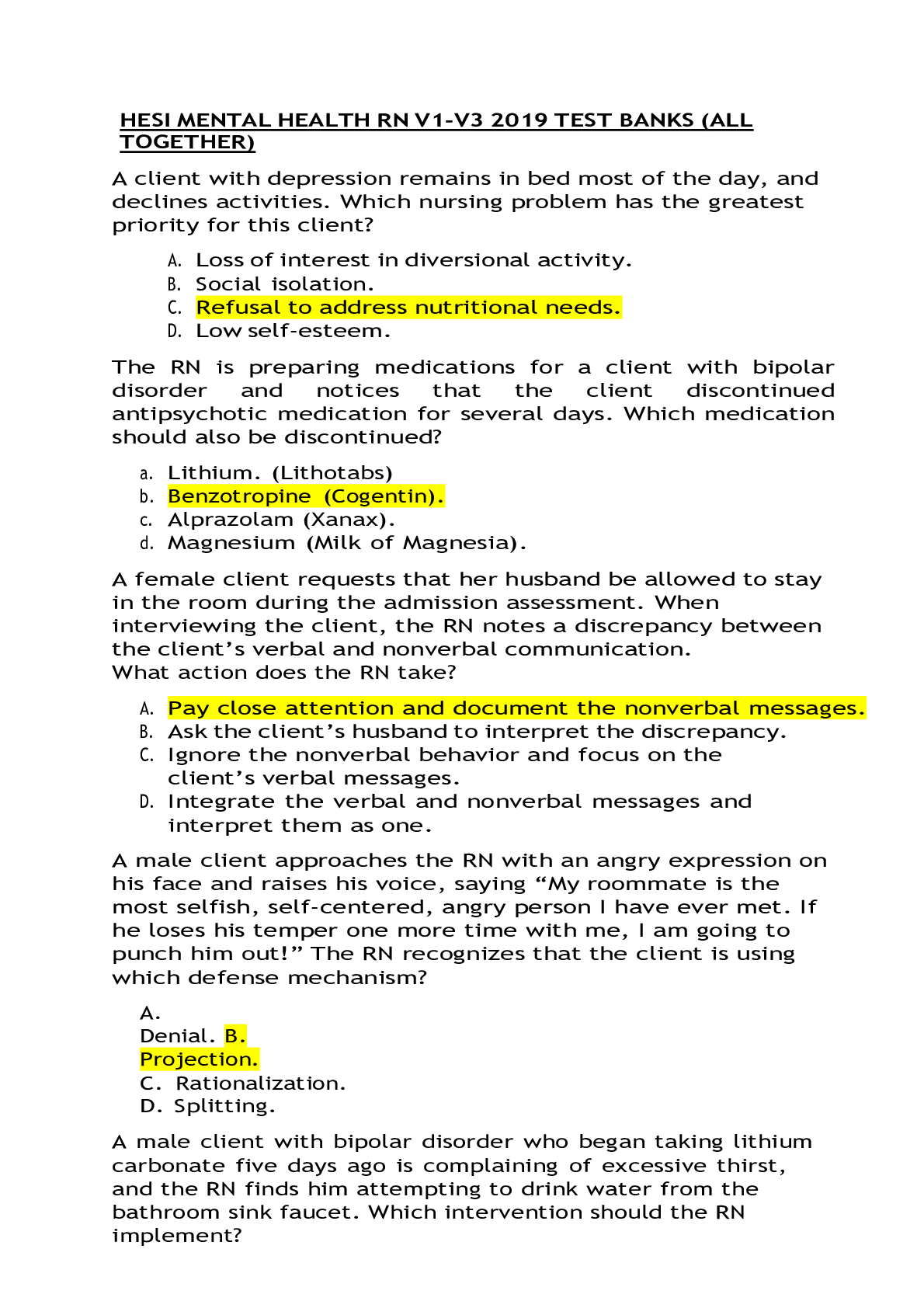
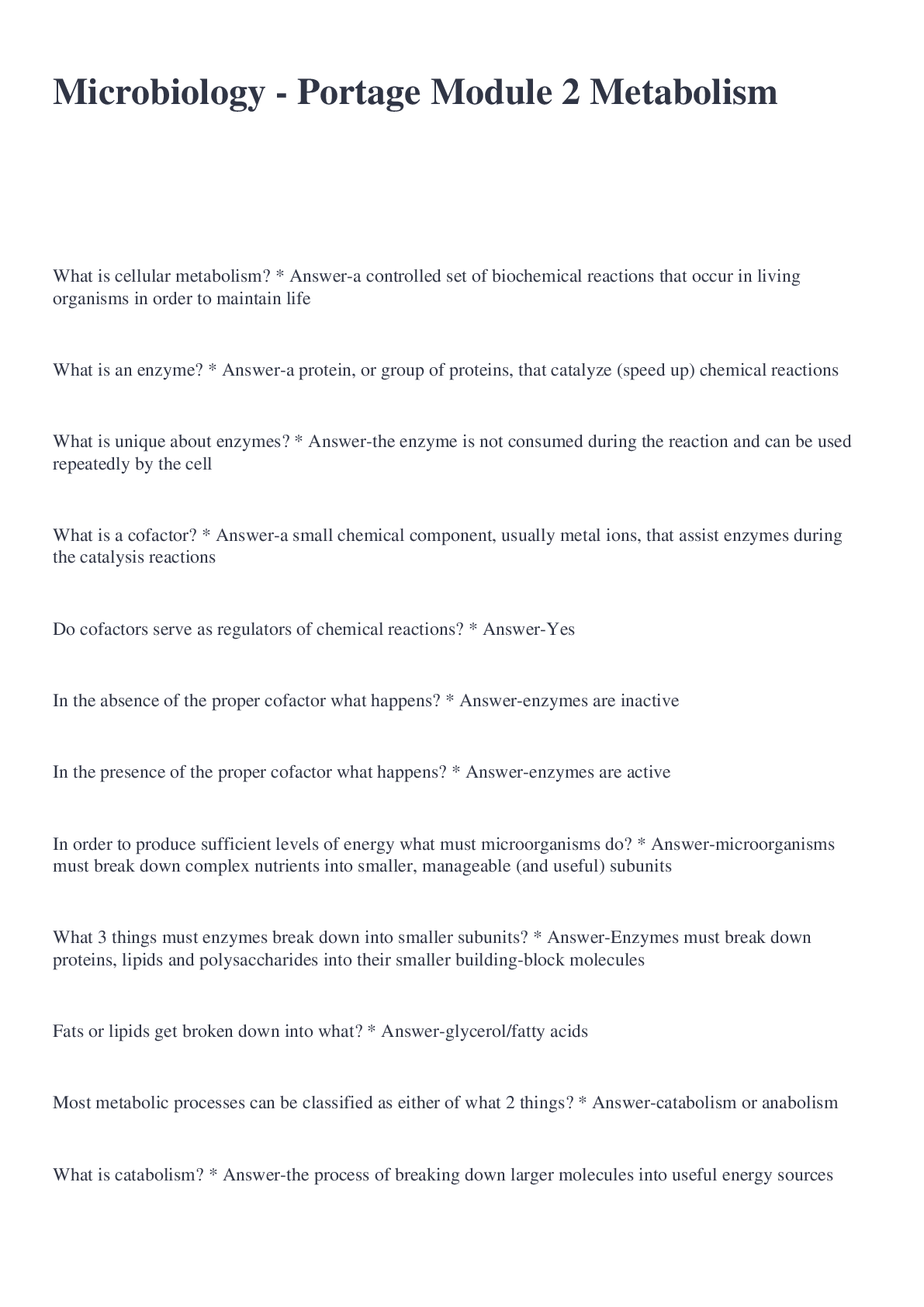



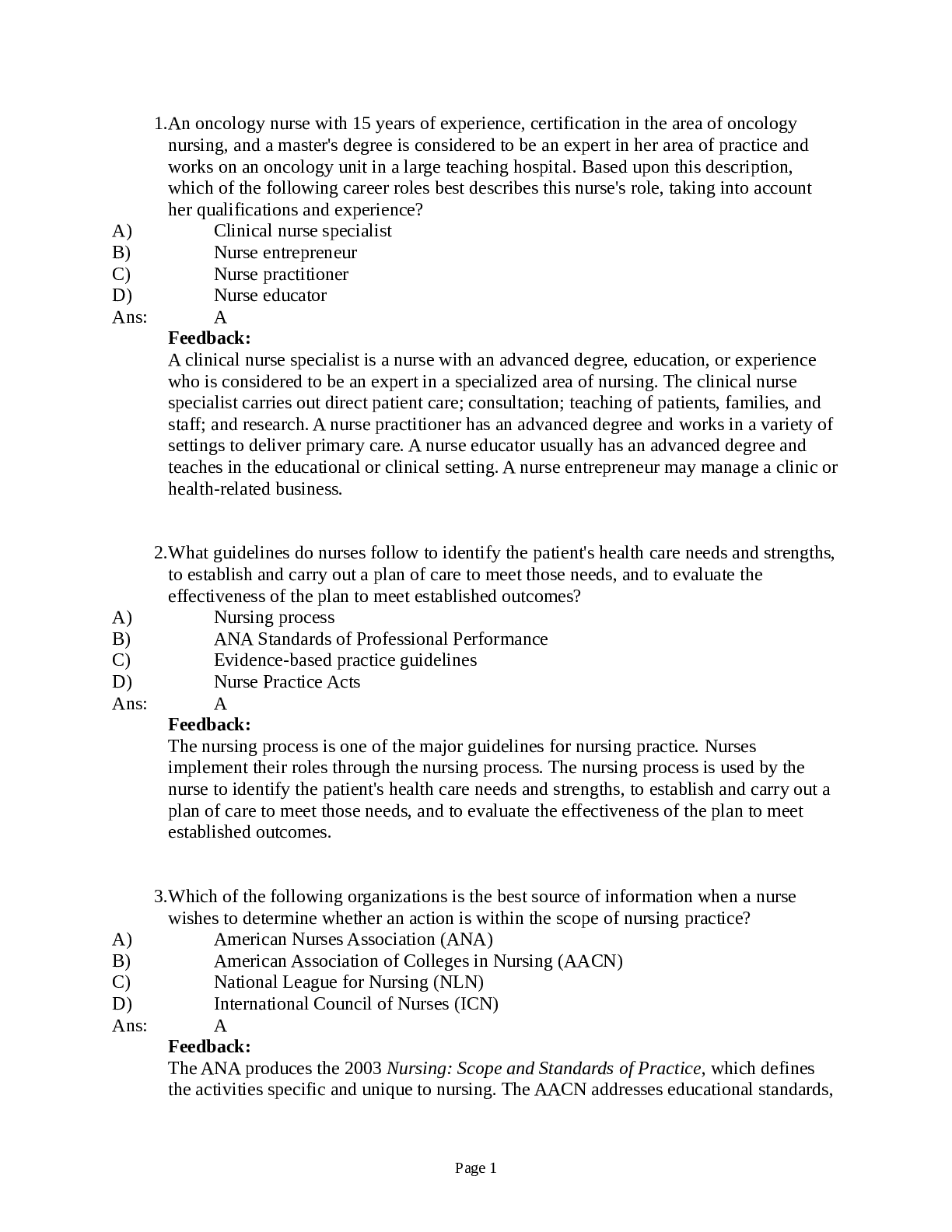
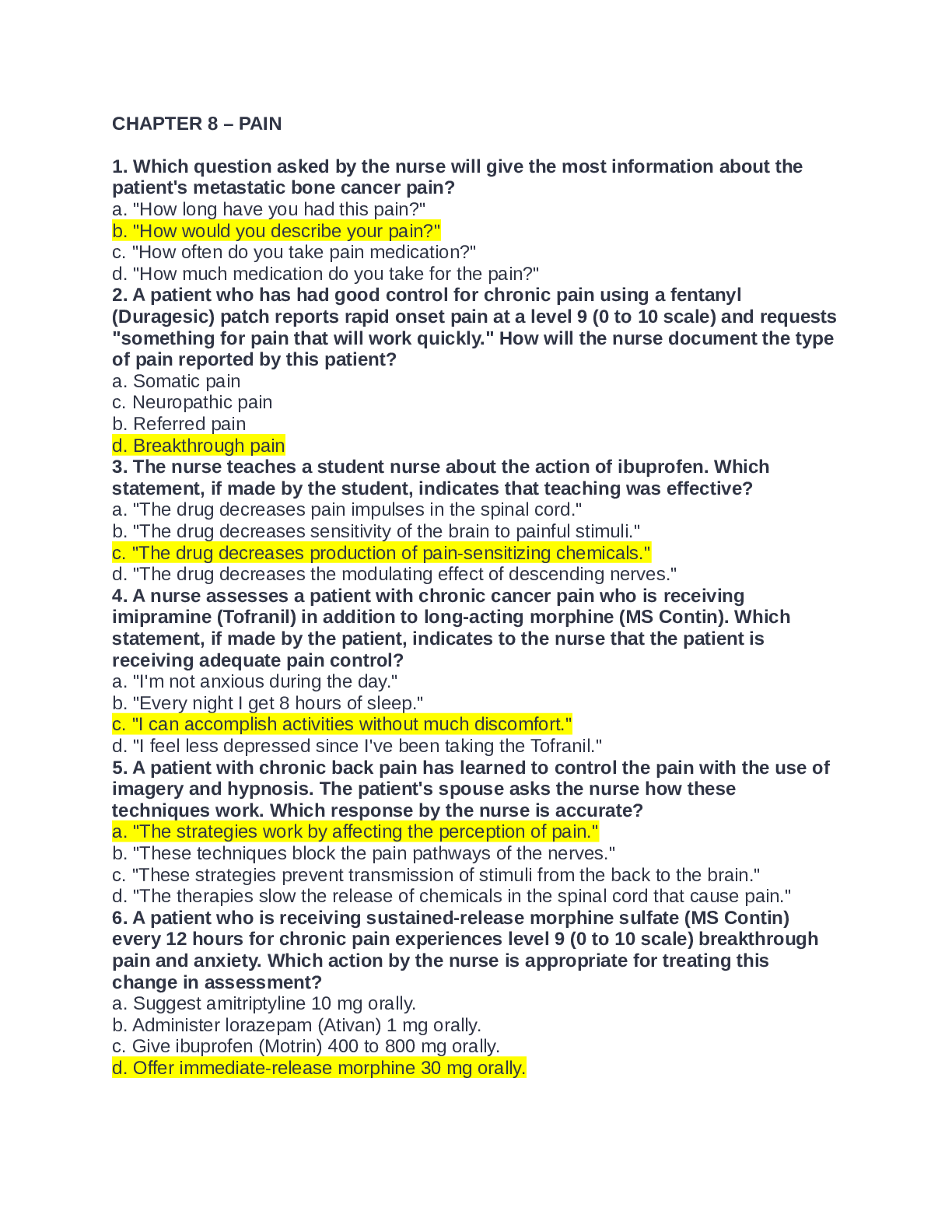
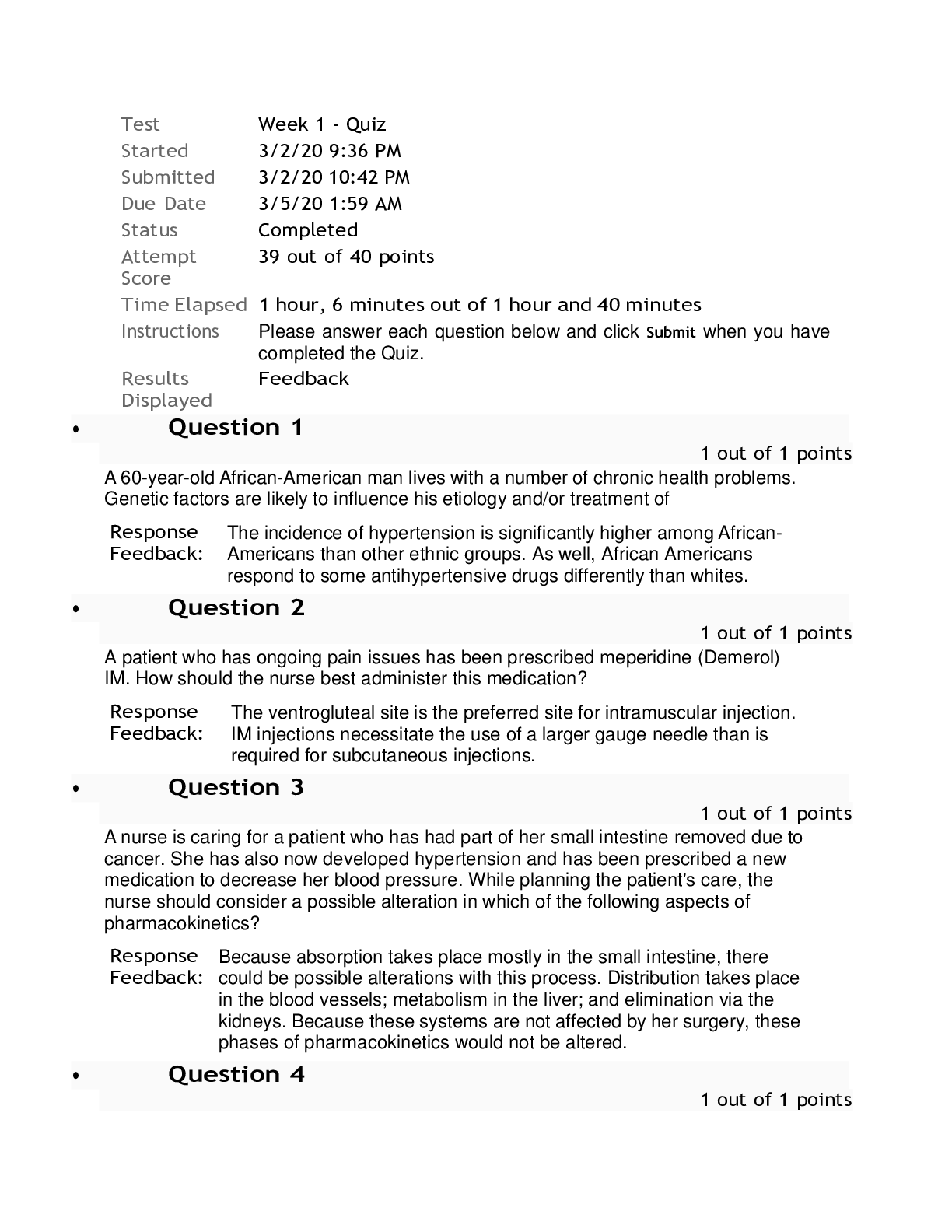



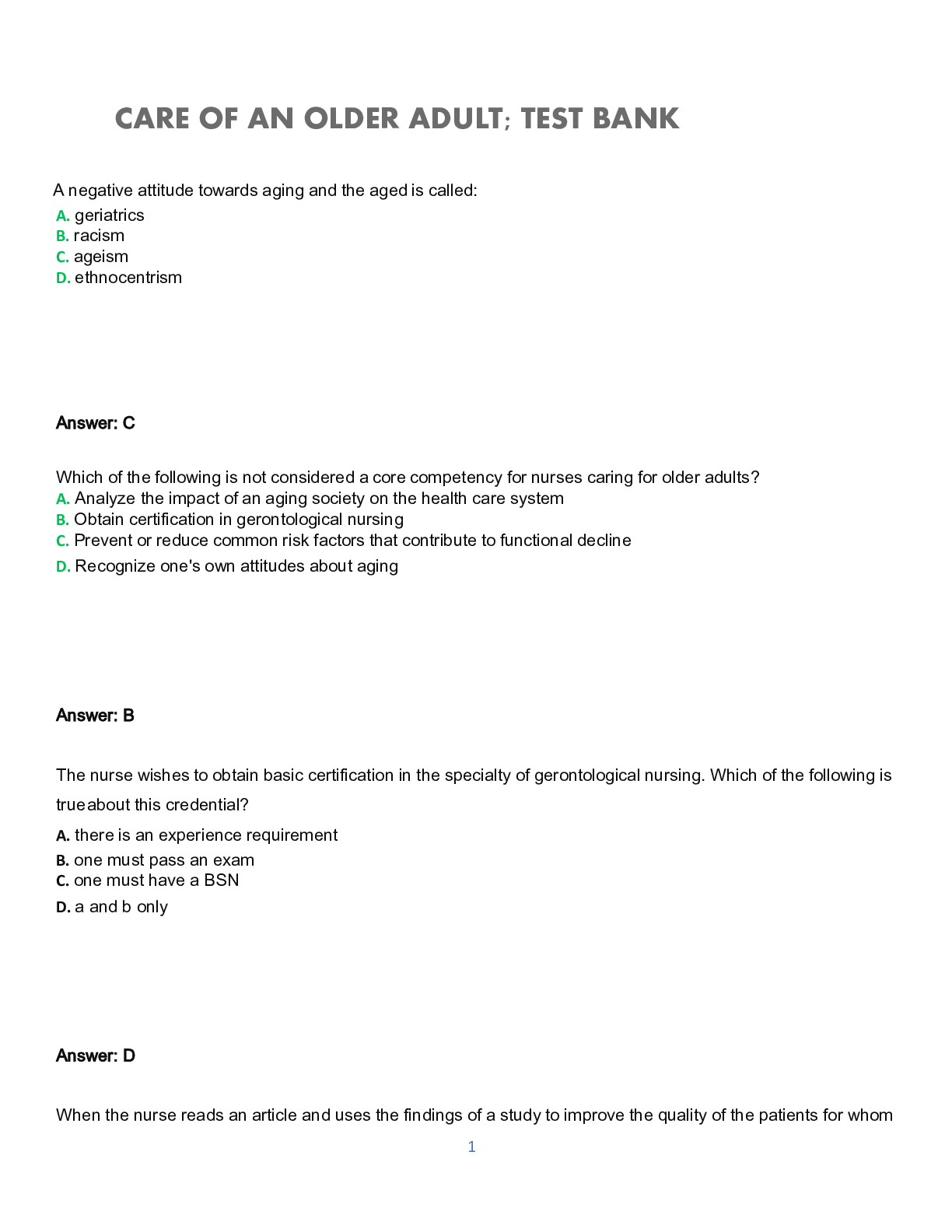
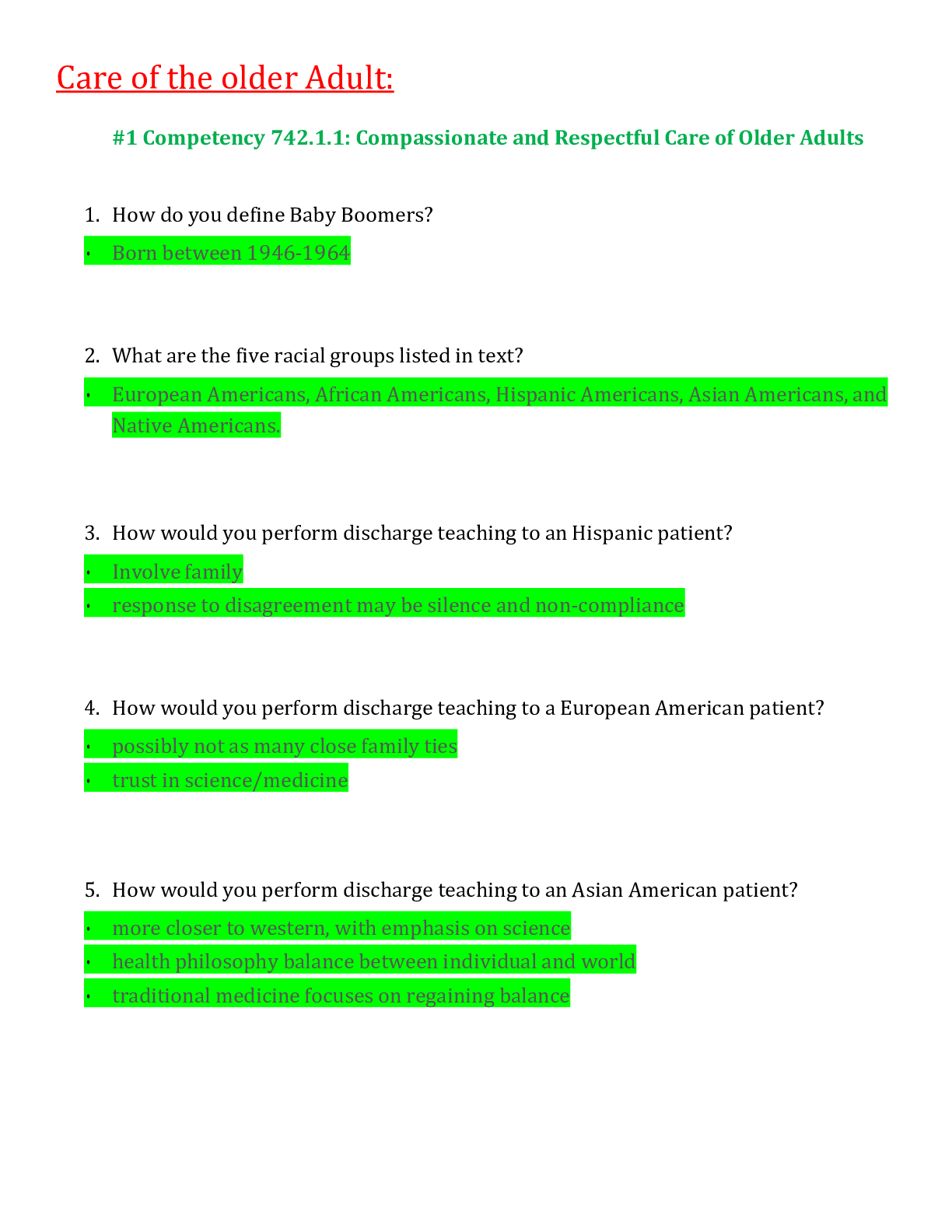
 Med Surg test Questions and Answers with Explanations, 100% Correct, Download to Score A.png)
, 100 Correct, Download to Score A.png)
, 100% Correct, Download to Score A.png)
, 100% Correct, Download to Score A.png)
, 100% Correct, Download to Score A.png)
, 100% Correct, Download to Score A.png)
, 100% Correct, Download to Score A.png)

